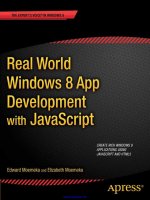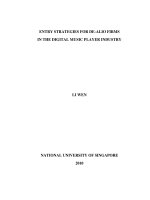Decentralized music player app development
Bạn đang xem bản rút gọn của tài liệu. Xem và tải ngay bản đầy đủ của tài liệu tại đây (2.13 MB, 60 trang )
VIETNAM-KOREA UNIVERSITY OF INFORMATION AND
COMMUNICATION TECHNOLOGY
Faculty of Computer Science
GRADUATION THESIS
DECENTRALIZED MUSIC PLAYER APP
DEVELOPMENT
Student:
NGUYEN DUY SY
NGUYEN THI NGUYET MINH
Class:
18IT5 + 18IT2
Supervisor:
Dr. TRAN VAN DAI
Da Nang, December – 2022
VIETNAM-KOREA UNIVERSITY OF INFORMATION AND
COMMUNICATION TECHNOLOGY
Faculty of Computer Science
GRADUATION THESIS
DECENTRALIZED MUSIC PLAYER APP
DEVELOPMENT
Student:
NGUYEN DUY SY
NGUYEN THI NGUYET MINH
Class:
18IT5 + 18IT2
Supervisor:
Dr. TRAN VAN DAI
Da Nang, December - 2022
SUPERVIOR’S COMMENT
<according to the template>
.........................................................................................................................................
.........................................................................................................................................
.........................................................................................................................................
.........................................................................................................................................
.........................................................................................................................................
.........................................................................................................................................
.........................................................................................................................................
.........................................................................................................................................
.........................................................................................................................................
.........................................................................................................................................
.........................................................................................................................................
.........................................................................................................................................
.........................................................................................................................................
.........................................................................................................................................
.........................................................................................................................................
.........................................................................................................................................
.........................................................................................................................................
.........................................................................................................................................
.........................................................................................................................................
.........................................................................................................................................
.........................................................................................................................................
.........................................................................................................................................
ACKNOWLEDGEMENTS
We would like to profoundly acknowledge the people who have helped me
during my studies:
First and foremost, we would like to thank my research supervisors, Dr Tran Van
Dai. Without his assistance and dedicated involvement in every step throughout the
process, this paper could have never been accomplished. We are extremely grateful to
you for supporting and understanding me during the past time.
We would like to acknowledge all lecturers at Vietnam Korea University of
Information And Communication Technology, for their valuable guidance throughout
my studies. You provided me with the tools that I needed to choose the right direction
and successfully complete my dissertation.
Finally, but not least, my warm and heartfelt thanks go to my family for their
tremendous support and hope they had given to me. Without that hope, this thesis
would not have been possible. Thank you all for the strength you gave me.
i
STATEMENT OF AUTHORSHIP
.........................................................................................................................................
.........................................................................................................................................
.........................................................................................................................................
.........................................................................................................................................
.........................................................................................................................................
.........................................................................................................................................
.........................................................................................................................................
.........................................................................................................................................
Danang, December 5th, 2022
NGUYEN THI NGUYET MINH
ii
TABLE OF CONTENTS
ACKNOWLEDGEMENTS.........................................................................................i
STATEMENT OF AUTHORSHIP............................................................................ii
TABLE OF CONTENTS...........................................................................................iii
ABBREVIATIONS.....................................................................................................vi
LIST OF FIGURES...................................................................................................vii
LIST OF TABLES....................................................................................................viii
INTRODUCTION.......................................................................................................1
1.
Problem statement....................................................................................1
2.
Aims and Objectives.................................................................................1
3.
Structure of the thesis...............................................................................2
CHAPTER 1.
DECENTRALIZED MUSIC STREAMING..........................3
1.1 Decentralized music streaming.............................................................................3
1.1.1
Remaining problems on centralized music platforms...........................3
1.1.2
Blockchain – the inevitable next stage of music?.................................4
1.1.3
Difficulty when music blockchain application.....................................5
CHAPTER 2.
THEORETICAL INFRASTRUCTURE.................................7
2.1 Blockchain.............................................................................................................. 7
2.1.1
List of top Blockchain features.............................................................8
2.1.2
How Does a Blockchain Work?.........................................................11
2.1.3
Blockchain Decentralization..............................................................12
2.1.4
Pros and Cons of Blockchain.............................................................13
2.2 Overview of Next.js.............................................................................................17
2.2.1
What Can You Build with Next.Js and When to Use Next.Js?...........17
2.2.2
Next.js Features..................................................................................18
2.2.3
Pros and Cons of Next.js....................................................................19
2.3 InterPlanetary File System IPFS........................................................................20
2.3.1
How does IPFS work?........................................................................21
2.3.2
IPFS features......................................................................................22
iii
2.3.3
Pros and Cons of IPFS........................................................................23
2.3.4
Potential applications of IPFS in Blockchain.....................................24
2.4 What is Django?..................................................................................................24
2.4.1
Learn about Django's MVT Pattern....................................................24
2.4.2
Why use Django.................................................................................24
2.4.3
Introduction to Django REST framework..........................................25
2.5 Alchemy in blockchain........................................................................................26
2.5.1
What is Alchemy?..............................................................................26
2.5.2
Supported networks............................................................................26
2.5.3
Alchemy interface..............................................................................26
2.5.4
APIs, documentation, and DX............................................................27
2.5.5
Pricing................................................................................................27
CHAPTER 3.
SYSTEM ANALYSIS AND DESIGN.....................................28
3.1 System analysis and design.................................................................................28
3.1.1
System requirements..........................................................................28
3.1.2
Use case diagram................................................................................30
3.2 Use Case specification.........................................................................................33
3.2.1
Use Case specification register...........................................................33
3.2.2
Use Case specification login..............................................................34
3.2.3
Use Case specification search.............................................................35
3.2.4
Use Case specification library............................................................35
3.2.5
Use Case specification discovery.......................................................36
3.2.6
Use Case specification create playlist.................................................36
3.2.7
Use Case specification create album..................................................37
3.2.8
Use Case specification upload song...................................................37
3.3 System deployment..............................................................................................38
3.3.1
Database Design.................................................................................38
3.3.2
System interface.................................................................................38
CONCLUSIONS AND SUGGESTIONS.................................................................42
iv
1.
Conclusions............................................................................................42
2.
Suggestions.............................................................................................43
REFERENCES..........................................................................................................44
v
ABBREVIATIONS
ABBREVIATION
MEANING
S
IPFS
Interplanetary File System
REST
Representational State Transfer
vi
LIST OF FIGUR
Figure 2. 1 The concept of blockchain..................................................................7
Figure 2. 2 How Does a Blockchain Work?........................................................12
Figure 2. 3 Decentralized Trust...........................................................................13
Figure 2. 4 Blockchain model compared to traditional model.............................14
Figure 2. 5 Security model of blockchain............................................................15
Figure 2. 6 The chart shows the development of industries in blockchain..........15
Figure 2. 7 IPFS Operation Process....................................................................21
Figure 2. 8 Django's MVT Model.......................................................................24
Figure 2. 9 Demo through REST web service.....................................................25
Figure 2. 10 Alchemy interface...........................................................................26
Y
Figure 3. 1 General use case diagram..................................................................30
Figure 3. 2 Use case diagram for register............................................................30
Figure 3. 3 Use case diagram for login................................................................31
Figure 3. 4 Use case diagram for search..............................................................31
Figure 3. 5 Use case diagram for personal library management..........................31
Figure 3. 6 Use case diagram for discovery........................................................32
Figure 3. 7 Use case diagram for create playlist..................................................32
Figure 3. 8 Use case diagram for upload song.....................................................33
Figure 3. 9 Design database system....................................................................38
Figure 3. 10 Discovery page interface.................................................................38
Figure 3. 11 Library page interface.....................................................................39
Figure 3. 12 Album page interface......................................................................39
Figure 3. 13 Mint NFT page interface.................................................................40
Figure 3. 14 List song page interface..................................................................40
Figure 3. 15 Player music interface.....................................................................41
vii
LIST OF TABLES
Table 3. 1 Indentify actors and use case..............................................................29
Table 3. 2 Use Case specification register...........................................................33
Table 3. 3 Use Case specification login..............................................................34
Table 3. 4 Use Case specification search.............................................................35
Table 3. 5 Use Case specification library............................................................35
Table 3. 6 Use Case specification discovery.......................................................36
Table 3. 7 Use Case specification create playlist.................................................36
Table 3. 8 Use Case specification create album..................................................37
Table 3. 9 Use Case specification upload song...................................................37
viii
CHAPTER 1.
INTRODUCTION
1. Problem statement
Over the years, "streaming services" have exploded and changed the habits of
both music listeners and creators of music.
In Vietnam, with the top 5 online music sites and hundreds of music download
sites, the number of music downloads is also very large along with the percentage of
Internet users. According to the current growth momentum, there will certainly be new
breakthroughs because copyrighted online music is the future of the world music
industry. Since then, the protection of online music copyright is also in place.
Before now, community-driven centralized streaming platforms like Spotify and
YouTube gave artists more freedom to express themselves with built-in legal
infrastructure support. However, the possibilities are endless with the advent of
decentralized music streaming platforms, which give more to music creators and
listeners.
Decentralized streaming platforms offer musicians more control over their music,
ensure transparency in royalty distribution, eliminate middlemen from music sales
(think record labels and distributors), boost revenue for musicians, eradicate the
musician/audience divide, and establish a point of origin for music creators.
In fact, artists like Lupe Fiasco, Gramatik, and Pitbull have advocated for
decentralized technologies in music, and proponents champion blockchain’s
distributed ledger technology.
2. Aims and Objectives
Over the last 10 years, the music industry has changed drastically because of the
internet and social media development. Artists have new mediums to share their songs,
and fans have many new ways to engage with and support their favorite musicians.
The music industry has its fair share of controversies, from monopolies to the
limited earning potential for up-and-coming artists. Because of this, projects are trying
to utilize blockchain technology to provide new solutions for the age-old music
market.
The purpose of our research at this time wants to build a decentralized music
player application based on blockchain technology, revolutionizing the rights and
royalties process, and ensuring artists, writers, publishers, and everyone in the music
industry value chain is paid appropriately.
1
3. Structure of the thesis
After the Introduction, the thesis is structured in three chapters:
Chapter 1, Decentralized music streaming. In this chapter. In this chapter, the
thesis presents the trend of decentralized music applying blockchain technology.
Chapter 2, Theoretical infrastructure. This chapter includes the theory of
blockchains, next.js, Interplanetary File System (IPFS), Django
Chapter 3, System analysis and design. This chapter defines system analysis,
system requirements, use case specification, system implementation
Finally, there are Conclusions, Suggestions, References and Appendices related
to the topic.
2
CHAPTER 1. DECENTRALIZED MUSIC STREAMING
1.2 Decentralized music streaming
Music streaming is one huge infrastructure right now driving the music industry
globally. Let’s face it, the growth of music streaming platforms has opened up new
opportunities for artists and listeners alike. Moreover, this growth is driven by musicloving Gen Z and Millennial’s, who prefer the subscription economy.
Notably, the U.S. alone has 82.1 million paid subscribers to on-demand music
streaming platforms, with global music subscribers surging 26.4% to 523.9 million
during the Covid pandemic. The overall ease of streaming music means that more
music lovers will keep listening to their favorite music for many years.
Before now, community-driven centralized streaming platforms like Spotify and
YouTube gave artists more freedom to express themselves with built-in legal
infrastructure support. However, the possibilities are endless with the advent of
decentralized music streaming platforms, which gives more to music creators and
listeners.
Decentralized streaming platforms offer musicians more control over their music,
ensure transparency in royalty distribution, eliminate middlemen from music sales
(think record labels and distributors), boost revenue for musicians, eradicate the
musician/audience divide, and establish a point of origin for music creators.
In fact, artists like Lupe Fiasco, Gramatik, and Pitbull have advocated for
decentralized technologies in music, and proponents champion blockchain’s
distributed ledger technology.
So if you are an upcoming musician or are a listener looking to try out
decentralized music streaming platforms, this is the piece you need to read as we’ll be
uncovering the top 10 decentralized music streaming platforms you need to know.
Without further fuss, let’s get this show on the road.
1.2.1 Remaining problems on centralized music platforms
Although, the online music industry has a lot of potential as well as room to grow
in the future. However, at the present time, this art form still has many inherent
weaknesses that seem to have not been untied:
Producer's benefits: Online music works are easily copied and plagiarized, so it
will be difficult to protect the rights of music creators thoroughly. As a result, this
producer's interests are affected, thereby reducing his interest in creating musical
works.
3
Music Copyright: The lack of a unified and standardized online music trading
platform for music copyrights makes trading music assets difficult and raises concerns
about the copyright of works.
Conflict in copyright law: Currently, there are still many contradictions in the
laws of intellectual property rights of musical works in many countries. Therefore, this
makes transactions related to this asset class difficult with high payment costs and long
verification times.
1.2.2 Blockchain – the inevitable next stage of music?
Coinbase is the first crypto company to have conducted an IPO. Coinbase has
built the largest centralized and regulated exchange for cryptocurrencies and digital
assets. Ultimately, the success of Coinbase has raised digital asset awareness for the
crypto industry, for the greater good. The same can happen with the creative
industries. Digital assets, be they collectibles or digital rights. Creative IP is a huge
untapped $500 billion asset class. With an exchange, this asset will benefit from a
great decentralized network. At its core, the answer lies in the fact that blockchain will
help manage rights better, more efficiently, and in a good protocol to deal with
copyright and royalties, thereby setting the stage for future decentralization. . Smart
contracts will become the application layer that turns the internet into the native
settlement layer, which means fewer middlemen and less computation and royalty
shuffling.
Copyright approval will also be facilitated by blockchain technology. Currently,
in the world music industry, one of the biggest challenges facing the copyright sector
is not having a centralized data warehouse where everyone can easily apply for a
license. For example, DJs often remix music (remix). If they ask for permission, they
have to find the producer, the main owner, and then determine if the artist is the one
authorized to approve the copyright… It's a journey that requires a lot of time and
effort. . While with a centralized data warehouse thanks to blockchain technology,
everything is solved with the click of a button…
Ujo, a New York-based company, provides a decentralized data storage platform
for music productions. Here artists can not only upload their works, but also keep
100% of the revenue and tips from the sale of their products without any fees. The
platform can automatically divide the commission among the collaborators of each
project. Another project, the Open Music Initiative, uses blockchain technology for
artists to copyright their music. This project is increasingly attracting more and more
4
artists from other platforms such as Soundcloud, YouTube, Spotify, Netflix, a
testament to applying the power of technology.Bruno Guez, CEO and Founder
Revelator, a blockchain-based digital asset and distribution platform for creative IP,
also outlined what it takes to decentralize music.
While implementing new technology is important, it is even more important to
capture and realize more value for creators. Decentralization can help the music
industry do just that, but the road ahead is long. Without protocol-level rights
management, the music industry will never fully reap the benefits of blockchain or
decentralization.
Blockchain technology is holding in hand a lot of potential tools, to break down
the barriers inherent in the music industry, help reduce costs, bring higher efficiency
and better income for artists. The advent of the Internet led to music streaming
platforms like Napster, Soundcloud and now Spotify bringing music to every corner.
Blockchain seems to be the next step when it comes to handing creators and listeners
back to the hands of record labels like Sony Music and Warner Music.
1.2.3 Difficulty when music blockchain application
It's also not easy for music companies to adopt blockchain technology, even
where the technology promises, and sometimes brings real creativity and efficiency in
areas where the music industry is concerned. really need it. The reason for this is clear:
It's what the current music industry needs and what blockchain systems do. As
Blockchain becomes popular, the first thing that must be said is that the number of
decentralized applications will increase. Meanwhile, the main value of the music
business comes from its ability to control creative intellectual property, and it's
essentially a centralized operation.
We have to understand what needs to happen to create a truly powerful and
diverse decentralized ecosystem for music. That system will be a hybrid system for
years to come, regardless of what some crypto miners want or some startups believe.
For the music industry to be fully decentralized and permissionless, some tough things
need to happen.
First, there needs to be a global copyright framework that can be chained.
Around the world, there are 240 systems of collective representation organizations
(CMOs). These 240 institutions will become the validating nodes on the network, the
computers that approve and ensure the correctness of transactions. Furthermore, there
will be a need for an online dispute resolution, counterclaim and complaint resolution
5
protocol that these organizations can engage with with all publishers and subpublishers worldwide.
Alternatively, there could be a staking mechanism for the right holder to use
collateral (probably virtual tokens) when they register the property, the collateral they
would lose if they breach the copyright. permission. This will solve the linking
problem and encourage good behavior. All of this is a big ask for the music industry.
Everything looks simpler if we consider it from the creator's side. They need to
register their copyrights and creative works on the blockchain. This is something we're
done with, but the next issue is who will pay for this technology and who will maintain
it, until it can sustain itself in a completely decentralized way.
Similar to how the Music Modernization Act established The MLC's collective
funding in the US, one could argue that a global copyright consortium of 240 CMOs
could jointly fund and launch run this new decentralized registry. Of course, things get
more complicated on the publishing side.
6
CHAPTER 2. THEORETICAL INFRASTRUCTURE
2.1 Blockchain
A blockchain is a digital ledger of transactions that is duplicated and distributed
across the entire network of computer systems on the blockchain. It is designed in a
way that makes it difficult or impossible to change, hack, or cheat the system.
Nowadays, most companies run on information. The faster it is received and the more
accurate it is, the better. Blockchain is ideal for delivering that information because it
provides immediate, shared and completely transparent information that can be
accessed only by permission network members. A blockchain network can track
orders, payments, production and much more.
Figure 2. 1 The concept of blockchain
Blockchain has made an impact on today’s technology by revolutionizing the
financial industry through the utilization of cryptocurrencies using decentralized
control. This has been followed by extending Blockchain to span several other
industries and applications for its capabilities in verification. With the current trend of
pursuing the decentralized Internet, many methods have been proposed to achieve
decentralization considering different aspects of the current Internet model ranging
from infrastructure and protocols to services and applications.
7
The blockchain was invented by Satoshi Nakamoto (alias of a person or a group
of 1people) in 2008 to deliver the public transaction ledger of the cryptocurrency
bitcoin. Based on its white paper, Bitcoin is "a purely peer-to-peer version of
electronic cash that would allow online payments to be sent directly from one party to
another without going through a financial institution". The invention of the blockchain
made it the first digital currency to solve the double-spending problem without the
need for an intermediary, such as a trusted authority or central server. Since Bitcoin
was raised, new blockchains and cryptocurrencies emerged.
The second-largest blockchain is Ethereum, a decentralized, open-source
blockchain with smart contract functionality. A smart contract is a simple program that
runs on Ethereum and it enables different activities, including decentralized
applications.
The key elements a basic blockchain is built on are transactions and blocks. The
transactions are used to keep track of the movement of an asset that can be tangible (a
product) or intangible (intellectual). For instance, we can use transactions to record the
state of an item during its production. A set of transactions is then collected into a new
block which is attached to the latest one inside the network. These blocks form a chain
of data as an asset moves from place to place or ownership changes. The blocks
confirm the exact time and sequence of transactions, and the blocks link securely
together to prevent any block from being altered or a new block being inserted
between two existing blocks.
A new block is linked to the previous one through the latter hash. A
cryptographic hash function is an algorithm that takes an arbitrary amount of data as
input and produces a fixed-size output of enciphered text called hash. A slight
difference in the input generates a completely different output. In this way, building a
new block based on the previous block hash ensures that middle blocks inside the
blockchain can not be altered.
Every time a new transaction occurs on the blockchain, it is added to every node
in the network. This results in a decentralized database managed by multiple
participants, known as Distributed Ledger Technology (DLT).
1.1.1 List of top Blockchain features
Blockchain technology has been around for quite some time now, still actively
being in the spotlight. Even though there are some mixed feelings toward this
technology, yet no one can entirely underestimate its role in the global economic
8
landscape. Blockchain technology isn’t just a backup network for cryptocurrencies, but
it offers a lot more.
9









